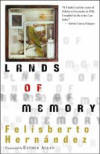Lands of Memory
Even if most English readers don’t know it, the influence of Felisberto Hernández’s writing can still be seen today in the work of Gabriel Garcia Marquez, Julio Cortazar, and Italo Calvino. Despite the recent trend of rediscovered Latin American writers, such as Roberto Bolaño, and their torrents of translated work, it is unsurprising that the foundations of Latin American literature are still being unearthed. Luckily, with this collection of two novellas and four short stories by Felisberto Hernández, one more influential Latin American writer’s work is finally available to English readers.
Even if most English readers don’t know it, the influence of Felisberto Hernández’s writing can still be seen today in the work of Gabriel Garcia Marquez, Julio Cortazar, and Italo Calvino. Despite the recent trend of rediscovered Latin American writers, such as Roberto Bolaño, and their torrents of translated work, it is unsurprising that the foundations of Latin American literature are still being unearthed. Luckily, with this collection of two novellas and four short stories by Felisberto Hernández, one more influential Latin American writer’s work is finally available to English readers.
Esther Allen’s Prologue to Lands of Memory is a fitting and helpful orientation to Felisberto’s work (“no one calls him Hernández,” Allen says). Felisberto was a reflective man who had a strange way of looking at things (often comparing pianos to coffins), and who nurtured obsessions over the opportunity to enter into “unfamiliar houses” and developing his own system of shorthand, which left some of the papers found after his death undecipherable.
Though the pieces in Lands of Memory were never published together, this collection is arranged chronologically. It opens with a novella entitled Around the Time of Clemente Colling, which recounts the narrator’s boyhood initiation into the world of classical music, and eventually his relationship with a blind pianist named Clemente Colling. The narrator, who I presume is based on young Felisberto, begins learning piano from Colling and eventually develops a fondness for the strange man for whom music seemed more important than his own physical existence.
Early in the story, describing his introduction to music, Felisberto examines his distant aunt Petrona, who “was very good-natured” but “concealed a certain tendency to brutal mockery,” especially during the impromptu piano concerts that often occurred in their family. Petrona would mock, and Felisberto says:
As usual, I raged inwardly. But one day I began to think that Petrona, despite not feeling the nocturne, not understanding or being included in it, or even aspiring to any situation or aesthetic state such as the one we were enjoying, did in her own way feel something of what was happening in those who were hearing and enjoying the moment of art . . . Like many people without intellectual cultivation – she barely read the newspaper – she felt a tension in her spirit when she was among ‘educated’ people; you could sense her batteries becoming overcharged at those moments, and whenever there was a chance to laugh she would let out a peel of violent laughter, more convulsive and lasting than anyone else’s.
The narrator seems to border on the snobbish, but then goes on to make a case for her generosity and tenderness. Felisberto oscillates between the concrete and the abstract, observing with an intuitive philosophical eye, attempting to see into the mysterious depths of human nature, attesting to his ability to reexamine events from different vantage points.
In “My First Concert in Montevideo,” young Felisberto is preparing for his first concert amidst great family turmoil. After the concert, he gets a job playing piano for a widow on the piano she had bought for a man who left her for another woman, a job which proves to be both disappointing and exhilarating. Like the rest of the collection, “My First Concert” has the feeling of an unlit room at dusk. Felisberto ends with a simple image whose subtle humor is the perfect ray of light at the close of this dark story. His ability to end stories so perfectly is truly impressive.
“The Crocodile” recalls the narrator’s days as a traveling salesman of women’s stockings who also arranges concerts in the cities he passes through. In the manner of most artists who must earn a living with work other than their particular art, the narrator is not very good at his day job and does not like it. He discovers that crying helps him to close a deal, and in a time and place where a crying man is a newsworthy occurrence, his ability to cry on command makes him famous. The tone of this short story, like that of the other stories “Mistaken Hands” and “The New House,” is more energetic, offering a nice break from the dense reflection of the opening novella. The last piece, another novella entitled Lands of Memory, is a bookend to the collection’s opener: Clemente Colling figures into the reflections again, except this time Felisberto is older and a seasoned pianist who has grown into a version of Colling and obsesses over women and recalls more of his bygone youth.
Digression and reflection are the meat of Felisberto Hernandez’s Lands of Memory. The book may be ordered chronologically, but the reflective diversions fracture these tales out of linear shape. Readers who require a story that gets from A to B as the crow flies will probably not enjoy the frequent digressions. But those who savor ideas and sentences rendered in unusual, beautiful, and insightful ways will appreciate Felisberto’s style. In his world, the digressions into the unknown and exploring the mysteries of human nature are among the most compelling reasons for beginning the journey, not necessarily the headlong rush toward the final destination.





